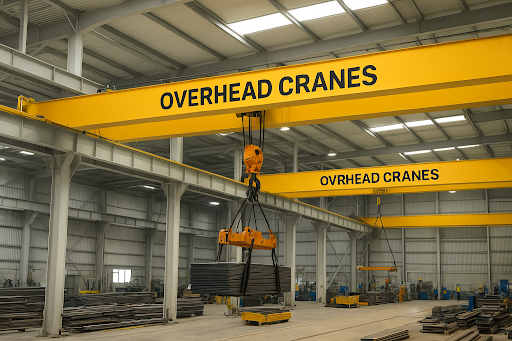The industrial sector has always relied on robust and reliable material handling solutions, and overhead cranes have become a cornerstone in modern manufacturing, logistics, and construction environments. These cranes are designed to move heavy materials efficiently and safely across factory floors, warehouses, and shipyards. With industries increasingly focusing on automation and productivity, the demand for overhead cranes is witnessing a steady surge worldwide.
The Overhead Cranes Market size was valued at USD 5.54 Billion in 2024 and is expected to reach USD 8.69 Billion by 2032, growing at a CAGR of 5.78% over the forecast period of 2025-2032. This growth is fueled by rising industrial activities, increasing investments in infrastructure, and the adoption of advanced crane technologies that enhance operational efficiency and reduce manual labor dependency. Industries such as steel manufacturing, automotive, logistics, and construction are significant contributors to market expansion, given their continuous need for high-capacity lifting and handling solutions.
Key Drivers Influencing Market Growth
Several factors are driving the growth of the overhead cranes market globally:
- Industrial Expansion: Rapid urbanization and industrialization, particularly in developing economies, are leading to increased demand for advanced material handling equipment. Overhead cranes offer efficiency in large-scale operations, which is essential in factories and warehouses.
- Technological Advancements: Modern overhead cranes are increasingly equipped with automation, IoT integration, and remote monitoring capabilities. These innovations not only enhance safety but also improve operational accuracy, making them attractive investments for industries seeking to optimize their workflow.
- Safety and Compliance Requirements: Strict workplace safety regulations across regions encourage companies to adopt overhead cranes. Their ability to handle heavy loads without manual intervention minimizes risks, meeting compliance standards in hazardous industrial environments.
- Cost Efficiency and Productivity: Overhead cranes reduce operational time and labor costs by efficiently transporting materials. For industries dealing with bulky and heavy items, these cranes are a more cost-effective solution than forklifts or other traditional material handling methods.
Market Segmentation Analysis
The overhead cranes market can be segmented based on type, capacity, application, and region:
- By Type: The market includes bridge cranes, gantry cranes, and jib cranes. Bridge cranes are widely preferred due to their versatility and ability to handle heavy loads across large spans. Gantry cranes are gaining traction in outdoor operations like shipyards and construction sites.
- By Capacity: Cranes are categorized into light, medium, and heavy-duty capacities. Heavy-duty cranes dominate industrial applications such as steel manufacturing and shipbuilding, whereas medium and light-duty cranes are increasingly used in warehouses and small-scale manufacturing units.
- By Application: The major applications include manufacturing, logistics, construction, and automotive. Among these, manufacturing and automotive sectors remain key contributors, driven by the need to move heavy machinery and automotive components efficiently.
Regional Insights
The growth of the overhead cranes market varies across regions:
- North America: Supported by established manufacturing infrastructure, technological adoption, and stringent safety regulations, North America remains a significant market for overhead cranes.
- Europe: With a strong focus on industrial automation and modernization of existing factories, Europe witnesses consistent demand, particularly for advanced and automated crane systems.
- Asia-Pacific: The fastest-growing region, driven by industrialization in China, India, and Southeast Asian countries. Expansion in construction, automotive, and steel production sectors contributes significantly to market growth.
- Rest of the World: Latin America, the Middle East, and Africa are emerging markets, with increasing infrastructure projects and industrial investments gradually boosting the demand for overhead cranes.
Competitive Landscape
The overhead cranes market is characterized by the presence of global and regional players focusing on innovation, product quality, and customer-centric solutions. Key strategies include product launches, mergers and acquisitions, and partnerships to expand market share. Companies are increasingly offering customized solutions tailored to industry-specific requirements, enhancing their competitive edge.
Conclusion
The Overhead Cranes Market is on a steady growth trajectory due to rising industrialization, technological advancements, and increasing safety awareness. With the market expected to grow from USD 5.54 Billion in 2024 to USD 8.69 Billion by 2032 at a CAGR of 5.78%, industries are increasingly adopting overhead cranes to improve operational efficiency, reduce costs, and meet modern production demands. The market’s dynamic growth across North America, Europe, and Asia-Pacific highlights the critical role these cranes play in supporting global industrial expansion.
FAQs
Q1: What is the CAGR of the Overhead Cranes Market?
A1: The market is projected to grow at a CAGR of 5.78% from 2025 to 2032.
Q2: What is the forecast period for market growth?
A2: The forecast period spans from 2025 to 2032.
Q3: Which regions are driving growth in the market?
A3: Asia-Pacific is the fastest-growing region, followed by North America and Europe.













